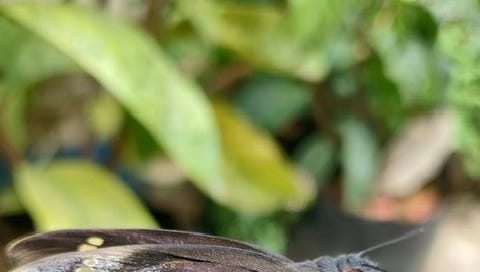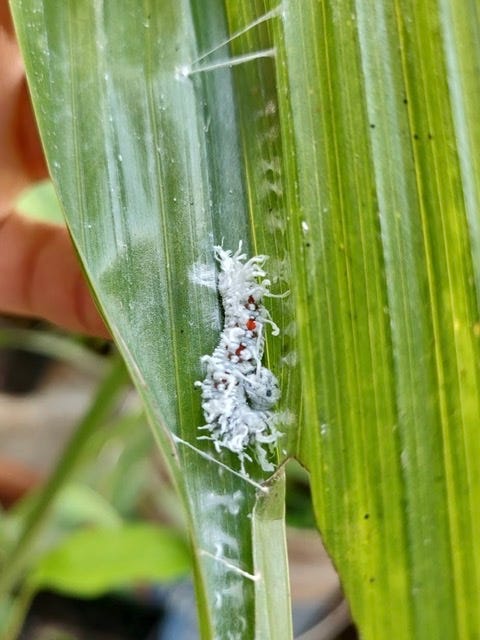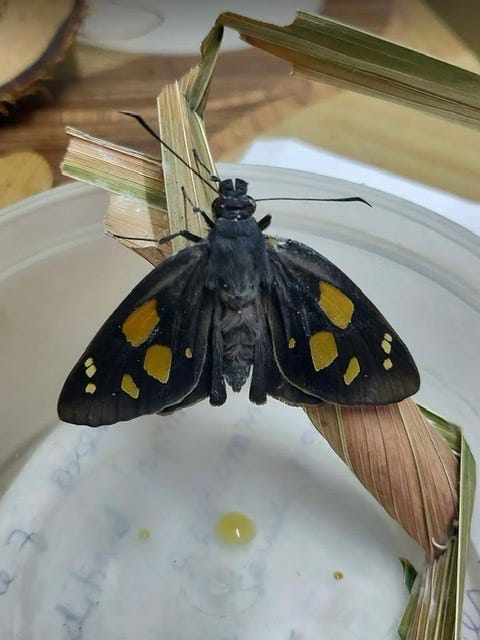I’m sure that many of us have looked at gardens and green spaces anew over these past twenty plus months. Whether that’s noticing things we might not have before, having a greater appreciation for them or growing in awareness of the inequity and privilege surrounding access to them. In this week’s newsletter, Elizabeth Soumya shares with us her experience of her garden in India, in which (in her own words) she found solace and healing during the pandemic and while coping with her dad's dementia.
Travelling to the backyard, by Elizabeth Soumya
It’s not your typical butterfly. The giant red eye, Gangara thyrsis. For one, it’s a skipper. Gets around with quick hopping darts in the secrecy of early evening hours. No leisurely flutters for this one. It flies with purpose. Its wings are hues of cold chocolate grey when shut and dark with drops of burnt yellow when open (which they scarcely are). It’s further obscured in the retracting evening light. When other butterflies that come to mind when one talks of butterflies - endearing, bright and well behaved - have nectared on dainty flowers and retired for the day, the Red Eye, incorrigibly crepuscular, peers into the coming night with its big electric red eyes.
On a dusky evening when the drone of strange insect sounds had picked up, the porch light was just switched on and in the distance warm yellow street light streamed on circling moths, a red eye made its way to the garden and laid its eggs. It carefully chose a young coconut palm with fresh frilled leaves. I had just weeks ago rescued an aged coconut that had survived a precipitous thumping fall in the garden. It lay pressed on soggy ground full of dark leaf litter and decaying coconut shells, uncared for, turning wet, soaking the monsoon downpours. It had so much water pelt on it, the hard shell of the seed inside relented and a sprout had popped out. No pot is big enough for a coconut tree. I disrespectfully forced it into a small terracotta container just right for decorative houseplants, the coconut caught hesitatingly in the mouth of the tapering pot.
Six months into the pandemic, the care home he went to in the daytime remained shut. My father’s dementia had progressed quicker than we had expected. Trapped between walls, his illness grated on him. Fed on isolation, his symptoms sharpened and grew louder. We would wake up on some days to find him reluctant to do the things he was able to even a day before. He would grip a spoon with his right hand, either too tightly, digging his nails hard into his palm or too flimsily, trying to scoop some rice and curry, spilling most of it over himself, dropping the spoon after each attempt, either accidentally or deliberately, refusing to try at all at some point. Frustrated he’d look at me accusingly, as if to ask why I was watching him but not helping. Monochromatic videos of his favourite Hindi cinema hero, Devanand bobbing his head stylishly, chasing coy heroines in chiffon sarees and puffed hair wafted into background blurs. He could not register them to sing along as before. Sometimes, I would help him practice his gait, lifting and placing the walker ahead of him, so he could follow it dragging himself behind. This left him crying and depressed. He wanted to sit, lie down, just give up.
There was nowhere to go. We walked monotonously up and down in a hallway, past a mirror in which he could see a strange version of himself - skin and bones, his stomach sucked in, his stubbled face, shoulders hunched over, only to move towards the table and back to his chair.
I tried to slip out from caregiving in the mornings, before my dad was up, with a warm cup of chai in my hands to scrutinise the butterfly eggs.
He’d wake up crying, anxious and irritated at finding that he couldn’t get himself out of bed. He’d realise this each morning and scream helplessly, entitled, until either my sister or I pulled him out into the day.
Ten days after the eggs were laid on the palm leaf, just rim marks remained. They had hatched. A few days on, I found weird squiggly worms, almost naked grey. They were not hairy or decorated with markings or colours. Soon they made slits in the frond and rolled a part of the leaf around themselves into tunnels to hide inside. They’d crawl out of these home cells whose walls were smeared with what looked like chalk dust and nibble on the leaf. As they grew, they were covered in white shaggy strings all over their bodies. An article about the red eye in a newspaper described them as ‘crawling threads’, the bizarre looking caterpillars were covered in thread like projections of wax resembling white yarn.
They had a single-minded purpose: self-care. When it was bright and sunny, they ate. When it was dark and the porch light lit up, they were still gorging. They ate and pooped round pellets of caterpillar fracas. They did not stop to poop, they pooped while they ate. Feeding and fattening themselves to propel their bodies into change. Even before the final metamorphosis, they went through smaller transformations - moulting their old selves into new caterpillars each time and returning to their obsessive binge. They crawled through these cycles oblivious to the big world and its perils.
The vaccine was not yet accessible in India. The pandemic ravaged through the globe making every new day seem uncertain. Preparing for the future was accepting there might not be one. I was embarrassed to secretly feel relieved that the catastrophe was common, the suffering, collective. Unlike the isolation of caregiving that separated you from others, now death was at every corner. Everyone was alone, together.
Even as someone used to working on my own, I felt adrift. I could no longer meet a friend in a coffee shop or drop into a book store or call a cousin over to be with my dad for a few hours. The backyard, which had always been a place of solace, drew me in deeper. Trapped, I was compelled to cultivate an intimacy with the immediate.
I stepped into the same garden I had tended for years. A few trees in the yard and a disarray of pots strewn on the terrace. But I stayed longer - digging, sowing, harvesting, staring. I thought I recognised these nooks well enough already, I had seen the trees when they were bought as saplings in black plastic grow bags before their roots meandered and sank deep into the soil. I knew what the ground looks like before weeds erupt in the rains each year. Yet, every time I wandered in, I noticed something I hadn’t before.
The leaves of the seven-year-old gooseberry tree had neat moon shaped cuts all around its edges. The leaf cutter bees had carved into them and flown out holding little bits of green to build cells to lay eggs in. Tiny alligator like caterpillars crawled on a nightshade plant. I found that they were larvae of ladybug beetles that fed on aphids. The ladybugs travelled through life cycles like butterflies, but I had never had the attention span, to look for these journeys around me.
When I took a closer look at a cobweb suspended between the pink jasmine bush and a soursop tree that had grown itself from discarded seeds, I found a spiny orb weaver that had a back shaped somewhat like a comic speech blurb. I later stumbled on a beautiful cream cocoon whose threads glistened when the light fell on it. It was spun, just as the web had been, by a skilled arachnid weaver spitting out salvia, turning them into silk to create the first shelter for its clutter of spiderlings. They emerged into the world one day as numerous moving dots caught in a cosy jumble of silk.
A naturalist mentor who teaches how to garden for wildlife, recommended I observe a creature’s behaviour when I find it. Knowing its name was not as important as observing it, she advised: “What was it doing? Why do you think it was there?”
The solitary ant wandering around lost is probably scouting for a new source of food, the butterfly that lands on your skin could be there for the salt in your sweat, the tailor bird scanning the garden floor is scouting for fibres from coconut shells to build a nest. Under its seemingly calm surface, nature is a chaotic functioning system, far from postcard pristine. Even green dots in crammed cities and gardens enable dizzying complexity and busyness of life.
I made a garden checklist, noting down species, families, time and date and the behaviours I had observed.
I logged in 17 birds, 27 butterflies, 10 spiders, 11 bees and wasps and 3 reptiles over a month’s observation.
My father had forgotten his name. And ours. These were hard to recall without assistance, but with a clue, maybe a first name, he usually caught on. Now he sat uninterested in the prodding. You don’t quiz a person losing their memory, you give them the answer readily, reinforce what they already know. We were taught this at a dementia caregivers’ meeting.
Sometimes I reminded him what my name was, “Elizabeth. Remember?” He’d nod in approval sometimes, at other times, he would look straight through me into an endless void. The information I tried to retrieve was useless.
I watched the caterpillars in the mornings every day and felt calmed by their smugness and overconfidence. Even though they had spent their entire lives in these chambers on exactly one plant, they’d have wings to fly freely someday.
The pandemic has churned a deep discomfort, a restlessness to escape the claustrophobia and uncertainty of our own lives. Nature peeping through a window, in the front or backyard in a world recalibrated by grief is an accessible distraction. The same tree outside that stood as a timeless monument, alive, but part of the flat landscape, turned into something with inflections of life - leaves changing, dropping, glossy new ones growing again, ants hiding in its wounds, gum seeping out from its scars, its regular rendezvous with a boisterous barbet in the late afternoons, small bats flitting around it in the moonlit afterhours. Our familiar surroundings are now the faraway escapes.
If these times have opened our senses to connect with nature better, they also amplify inequity. Is slipping into nature a cop out from reality? Not everyone has the opportunities and resources to access it or the mind space to tune into bird calls while trying to clutch at the falling bits of one’s world spinning around. At the peak of the crisis, while millions sat trapped in their homes, their chests heavy with an ominous foreboding, on hospital beds, unable to say their final goodbyes, it felt unfair to have the luxury of a garden, obscene even to derive pleasure from digging into dirt. Does displaying our love for nature, especially on social media, stem from the same vulgarity of privilege, a disconnectedness from the pain and experiences of others?
Both my dad and I made it through Covid-19 this year, through India’s frightening second wave. I stayed indoors, opening just a bit of a backdoor to peep at a neighbour’s coconut tree, its branches nodding in the breeze against the basic summer sky – blue, with big white clouds, but it felt strangely luminous after having stared at my ceiling for days. My sister cared for my father - double masked and trying to maintain distance, but still having to be close, helping him up in the mornings, spoon feeding him, pacifying him when he became irritable and upset with the isolation. All the while trying to not be infected. And I requested her timidly quarantined indoors, “Could you water the plants?”
One evening in October, with tiring rains outside, I sat at my desk writing. A giant red eye butterfly had emerged from the safe cell it had entered into for its long transformative sleep. I wanted to witness the metamorphosis, so had brought two of the leaf rolled cells indoors. I had expected it to emerge in the morning. It patiently initiated itself into a brand new life – perched on the end of the leaf tunnel it pumped fluids into its delicate wings to strengthen and stiffen them. It sat with the wings open, drying them. Then it furled and unfurled its proboscis, merging what were two strips into one long tongue. As I was typing on the keypad, I saw it in the background preparing for its first flight.
The next day, I found a red eye in the garden, one of its forewings was torn. As it tried to launch into flight, it fell sideways each time and finally moved close to a tiny puddle and took a drink.
Elizabeth Soumya is a writer and gardener based in Bangalore, India. She loves foraging and observing urban wildlife go about their city life. She spends a lot of time in her small garden, where she grows vegetables and pollinator plants. She believes that gardening and green spaces must be accessible to all. She shares updates from her garden on Instagram @liz_in_the_garden
She is being paid for this article.
Photo credits: Elizabeth Soumya






